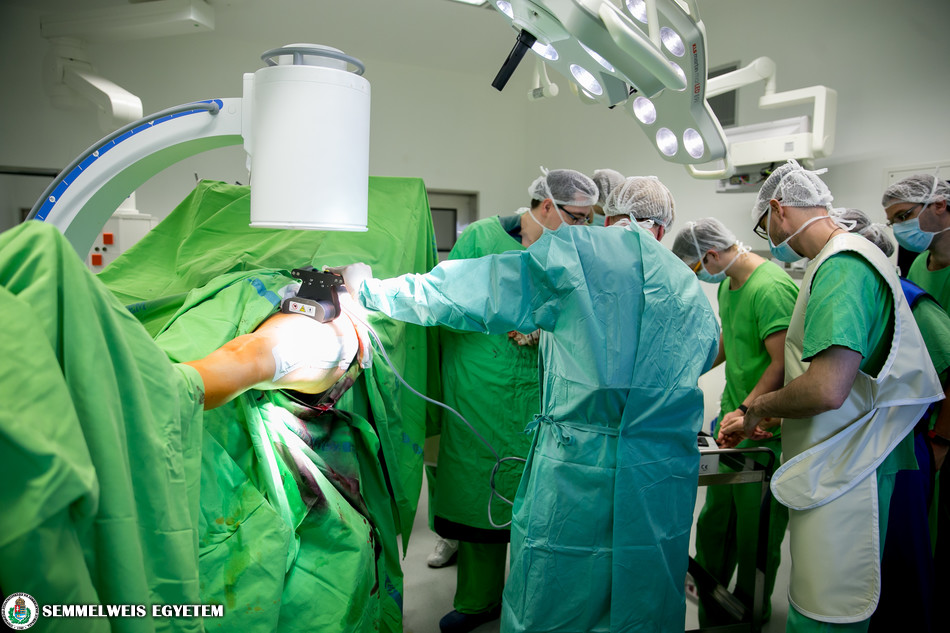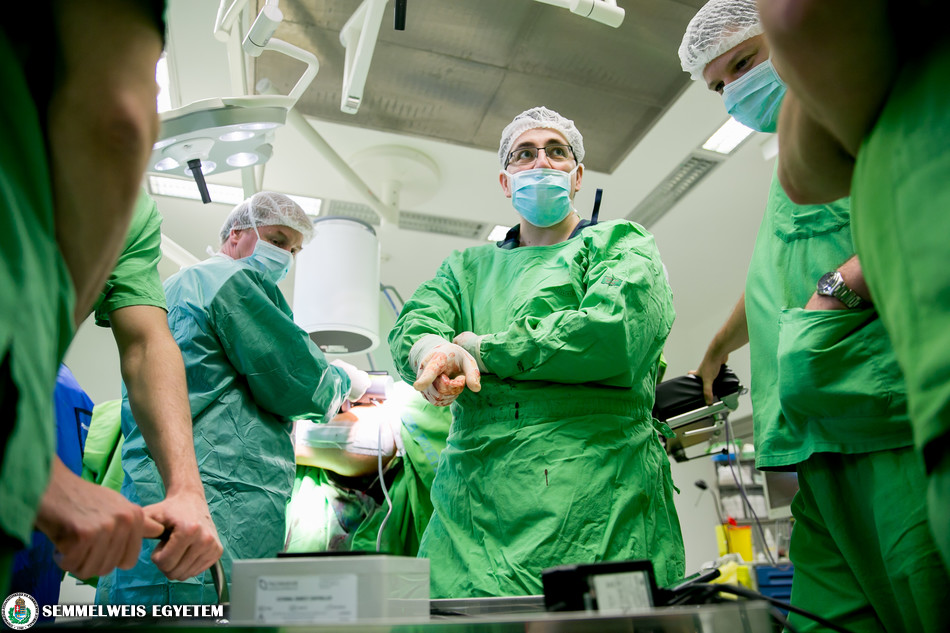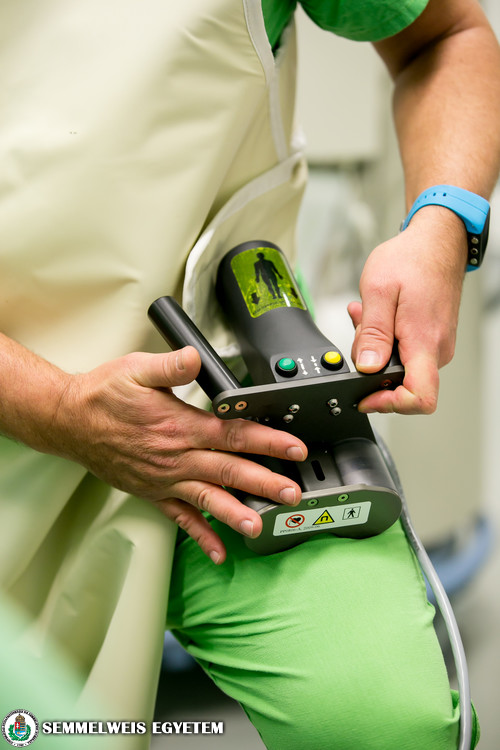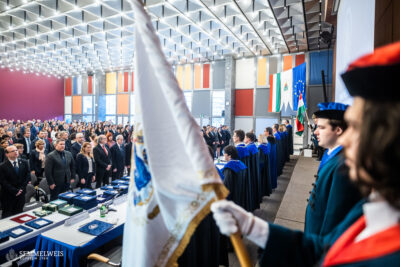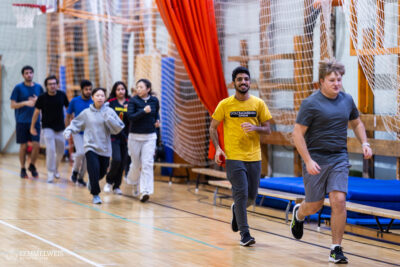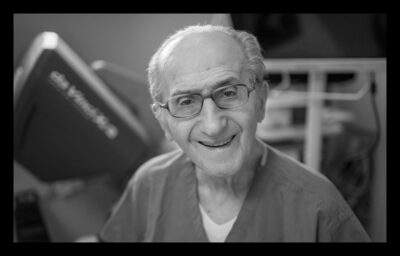A limb lengthening operation using a PRECICE magnetic intramedullary (inside the bone) nail was performed for the first time at Semmelweis University’s Department of Orthopedics, which also marked the first operation of its kind in Hungary. The surgical demonstration was performed by Dr. Peter Calder, who arrived from London, while a second surgery was then carried out by Dr. Gyula Domos, an assistant lecturer at the department. The British orthopedic surgeon, who visited the department with his colleague Dr. Robert Hill, also brought a donation of special external fixator devices used in limb lengthening.
 Two renowned British orthopedic surgeons have completed a three-day visit to the Department of Orthopedics. Dr. Robert Hill, the senior orthopedic surgeon at Great Ormond Street Hospital, the famous children’s hospital, brought for the second time a donation of special Taylor Spatial Frames for the department, which are external fixators used in limb lengthening and reconstruction procedures. Thanks to the previous donation made in 2013, 25 children and adults have been operated on during the past few years, and as a gesture of gratitude, a framed board containing a collection of their photographs was given to the British orthopedic surgeon in an official ceremony.
Two renowned British orthopedic surgeons have completed a three-day visit to the Department of Orthopedics. Dr. Robert Hill, the senior orthopedic surgeon at Great Ormond Street Hospital, the famous children’s hospital, brought for the second time a donation of special Taylor Spatial Frames for the department, which are external fixators used in limb lengthening and reconstruction procedures. Thanks to the previous donation made in 2013, 25 children and adults have been operated on during the past few years, and as a gesture of gratitude, a framed board containing a collection of their photographs was given to the British orthopedic surgeon in an official ceremony.
The Taylor method and toolkit, which has been used in Hungary so far only at Semmelweis University’s Department of Orthopedics, is unique in that the software it contains can be used to model limb deformities that are to be corrected, and these corrections can be planned ahead of time. Using the Taylor limb lengthening devices, even complex limb deformities can be treated more successfully and with fewer complications than with earlier-used external limb lengthening frames.
During the current visit, Dr. Peter Calder, who works at the Royal National Orthopaedic Hospital in Stanmore, U.K., held a surgical demonstration at the department: he performed for the first time in Hungary an intramedullary limb lengthening on a patient whose lower limbs differed 4 centimeters in length. Following the demonstration, the second operation of its kind on a Hungarian patient was performed by Dr. Gyula Domos, an assistant lecturer at the department; in this case the difference in the length of the lower limbs was 4.5 centimeters.
Until now, only limb lengthening procedures using external fixators have been performed in Hungary, with the lengthening of the limbs carried out by the periodic manual adjustment of the rods connecting the various parts of the frame attached to the patient. In this case, the mechanism used for the lengthening – two or three large metal rings – are attached to the bone inside the limb with metal or wire pins through the skin and soft tissue, while in the case of the new, intramedullary nail there is no external mechanism, nothing can be seen on the patient, explained Dr. Gyula Domos. With this new method – which was introduced to the Department of Orthopedics with the support of its director, Dr. György Szőke – the gradual lengthening of the bone is carried out via an external magnetic control: the special nail implanted in the medullary cavity can be controlled with a tool that generates a magnetic field, and which the patient has to place above the skin for only two minutes, three times a day. Using this procedure, the limb can be extended by one millimeter each day, while the surrounding soft tissue and muscles remain intact, stressed Dr. Domos. He added that the process interferes less with the patient’s everyday life and causes much less strain than the other, external lengthening method. In addition, in the latter case – depending on age and the size of the length difference – the period during which the patient has to wear the uncomfortable external frame can last from six months to two years.
 Limb lengthening helps people whose lower limbs differ several centimeters in length, which can be due to a developmental abnormality, an accident, a tumor or an inflammation of the bone. The intramedullary limb lengthening procedure is recommended for patients where the difference between limb lengths is at least 3.5–4 centimeters. Dr. Domos believes that 15–20 patients a year may require such an operation in Hungary, and the Department of Orthopedics hopes that after the positive experiences of the first two operations are assessed, social security will support further such procedures, following evaluation on a case-by-case basis.
Limb lengthening helps people whose lower limbs differ several centimeters in length, which can be due to a developmental abnormality, an accident, a tumor or an inflammation of the bone. The intramedullary limb lengthening procedure is recommended for patients where the difference between limb lengths is at least 3.5–4 centimeters. Dr. Domos believes that 15–20 patients a year may require such an operation in Hungary, and the Department of Orthopedics hopes that after the positive experiences of the first two operations are assessed, social security will support further such procedures, following evaluation on a case-by-case basis.
Dr. Peter Calder, who held the surgical demonstration, performs the most operations of this kind involving a PRECICE magnetic intramedullary nail in Europe, and Dr. Gyula Domos previously worked together with him in order to gather experience.
Pálma Dobozi
Translation: Tamás Deme
Photo: Attila Kovács – Semmelweis University
